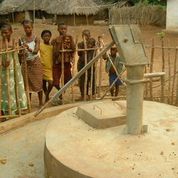Water, human rights and reputations – managing the impacts of mining projects
 What’s the connection between access to water, human rights and mining projects? It’s a complicated area where the vast challenges that lie ahead can only increase as the century progresses. The predicted effects of climate change – like variations in temperature and precipitation – are set to create further conflict. Solving these problems calls for imaginative thinking and concentrated effort to manage water responsibly, protect important human rights and safeguard reputations.
What’s the connection between access to water, human rights and mining projects? It’s a complicated area where the vast challenges that lie ahead can only increase as the century progresses. The predicted effects of climate change – like variations in temperature and precipitation – are set to create further conflict. Solving these problems calls for imaginative thinking and concentrated effort to manage water responsibly, protect important human rights and safeguard reputations.
By 2025, the Intergovernmental Panel on Climate Change predicts that about 60% of the world’s population will be living in countries defined as ‘water stressed’. And according to the credit rating agency Moody’s, water scarcity is already changing the mining landscape as environmental legislation becomes more stringent. “Operating in some countries increases political risk as mining companies’ water supplies can be restricted if the needs of communities increases,” says Moody’s; “this is in turn increasing the pressure and risks for mining companies and can affect their credit ratings.”
Water is indispensable to life. It’s fundamental to human rights. But it’s also essential for developing and operating mining projects that are often water-intensive. The general perception is that mining projects use a large percentage of the global water supply. The actual figure sits at around 5%. Sensitivity inevitably arises through conflict and competition with other water users. Whether real or perceived, both aspects need managing.
Competing demands for water make it essential that the mining industry carefully considers responsible water usage throughout every phase of every project. This includes embedding the right mitigation measures to avoid and reduce impacts on water resources – like the failure of tailings facilities, groundwater contamination, reduction of the water table through mine dewatering, acid and metalliferous drainage, and impacts on ecosystems service users.
At a higher level still, the real challenge for the mining industry is to successfully manage the connection between water management and human rights – including recognising where projects have the potential to help and support them.
Developing trust with local communities
But the best place to start is actually on the ground – understanding the concerns of local people. Water is always a priority, and perceptions of the risks that mining projects pose to the quality of and access to water supply may extend far beyond the reality. Increasing public awareness and understanding is therefore essential.
In rural Kazakhstan, for example, when I was out on site talking to local villagers at an exploration project, they started raising their concerns. Before I knew it, I’d been given a glass of very saline tasting water from a local well. The community wanted to know whether the development of the mine would create any adverse impacts on their water supply or benefit them through infrastructure improvements – in their case through the redevelopment of an abandoned water pipeline from a nearby town.
On sites like this, the use of water and right of access need carefully managing and prioritising to avoid conflict arising between water users. The right mitigation measures are needed to avoid creating further divisions or impacts on human rights. And communication and transparency are absolutely key in developing trust with local communities.
In many areas of rural sub-Saharan Africa such as Burkina Faso it’s the women who collect water – often from sources a long way away. Any impacts on local water resources can therefore affect their lives in very real ways, with indirect consequences such as safety implications if they have to walk even further. Understanding how communities function – including identifying vulnerable groups – should be integrated into the conceptual stages of a project so that suitable mitigation measures can be put in place.
But providing benefits to local communities can also sometimes present ethical dilemmas. In assessing how they can improve infrastructure, for example, mine operators need to look well beyond their initial involvement to their possible future responsibilities. What happens if there are impacts on water quality after the closure of the mine? How should they respond if health implications emerge that are associated with the standard of water they provide? What if the standard is enhanced for the local community, yet still falls below the drinking water quality they provide to their work force? And how should they answer the charge that by engaging in community development projects they’re simply trying to buy the support of local people?
Constantly evolving
One area of special difficulty is where a mining project is located on or close to a national or regional border. Trans-boundary issues often pose major challenges to corporate water stewardship, increasing the political ramifications and the need to engage with a wider number of stakeholders. In El Salvador, for example, where more than 60% of the population may rely on a single source of water, a moratorium was put in place in 2009 on permits for the development of metalliferrous mines. Concern over existing water scarcity and stress was further heightened by possible trans-boundary impacts from the development of mining projects in neighbouring Guatemala. Regional competition for one main water resource may also exist where access to water is close to a number of ore bodies, causing competition in surrounding communities.
The 1992 United Nations (Economic Commission for Europe) Water Convention aims to protect the use of trans-boundary water courses and international lakes by ensuring equitable water management. The Espoo Convention also emphasises the importance of identifying and mitigating trans-boundary impacts, including through consultation with neighbouring countries.
Looking more broadly at the legal definition of access to water as a human right, it’s clear that this is an area that’s constantly evolving. At present it’s defined in indirect terms, such as the right to water and sanitation being an indirect part of existing international law taken from the International Convention on Economic Social and Cultural Rights (1966). This is a legally binding treaty that obligates states to provide the right to an adequate standard of living and the right to health. Indirectly, without the right to water, the right to an adequate standard of living and health cannot be achieved.
In 2002, the Convention on Economic, Social and Cultural Rights defined the right to water as “sufficient, safe, acceptable, physically accessible and affordable water for personal and domestic uses”.
The UN Guiding Principles ‘Protect, respect and remedy framework’ (released in 2011) is one of the fundamental guides for businesses on human rights. This framework specifies that businesses should as a minimum respect all internationally identified human rights, including the International Covenants on Civil and Political Rights and on Economic, social and cultural rights, and the eight International Labour organization Core Conventions.
Recent changes to the UK Companies Act require large UK listed companies to cover human rights aspects in their annual reporting, such as disclosing their human rights policy. This may well become a universal benchmark.
Future challenge
At an international level then, technical frameworks are helping to advance the development and interconnection of water management and human rights – as are the implementation of other environmental and social standards. But how should mining companies be responding and evolving their practices – and how can they benefit?
The future challenge is all about gaining a high level of understanding of communities and how they use water. The combination of well-founded hydrogeological investigations and social studies can help determine community uses of water and identify safe access to water resources. Good water stewardship is beneficial for a company’s reputation and stakeholder support. It can enhance its ability to gain further exploration and mining licences, including water permits. It also reduces possible delays to a project.
Some of the large mining companies are actively involved in monitoring their implementation and contribution to the (2014) UN Millennium Development Goals. This monitoring describes how since 1990, over a quarter of the world’s population has gained access to improved sanitation and drinking water.
Political interest in the UK certainly seems high. A recent House of Commons seminar, hosted by Wardell Armstrong in conjunction with the All Party Parliamentary Group for the Extractive Industry (APPG EI), saw a committee room packed with representatives wanting to listen to speakers discussing lessons learnt and solutions needed to integrate human rights considerations throughout the mine life cycle. This particular seminar had one of the largest turn-out ever recorded for an APPG EI meeting.
At a site and at corporate level, companies can and should increase the integration of their teams to help understand and manage the cross-cutting considerations of human rights, including an assessment of different social and environmental impacts. At a site level, departments need to work closely together to share information. At corporate level equally, executives need to make sure that their initiatives are fully understood at their sites, and that they give support to positive action taken on the ground. To make sure that every individual mining project identifies and addresses these critical issues, operators need to carry out a review of potential and actual human rights impacts through a due diligence or audit process. If serious concerns are raised, a more in-depth human rights impact assessment may be needed. And in every case, the initial review should be followed up regularly by further reviews of conditions on site.
Only in these ways can the industry be sure of using and managing water in responsible ways, protecting human rights, and in turn safeguarding its reputation.
Dr Elizabeth Adey, social specialist
More News
{{ commodity.name }}
{{ post.title }}
{{ post.date }}




Comments
Nick Shepherd - EduVision Inc.
We worked a few years ago with a mining operation in Alaska to help them develop a statement of “Values” which forms the foundation of organizational behaviour and therefore the decisions that the organization makes. This “touchstone” helps act as a reminder of the foundational aspects of what the organization stands for, which should be linked back to the expectations of society through which an organization sustains its’ “License to Operate.” These are indeed becoming critical success factors and organizations without such commitments to guide behaviour will find themselves increasingly being challenged.